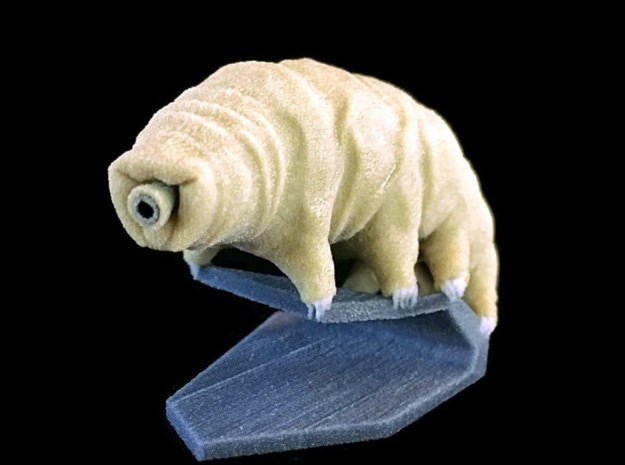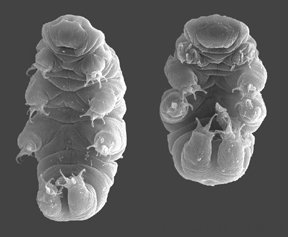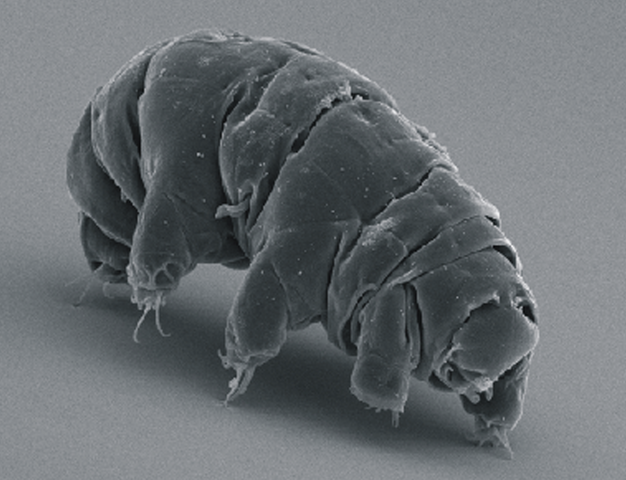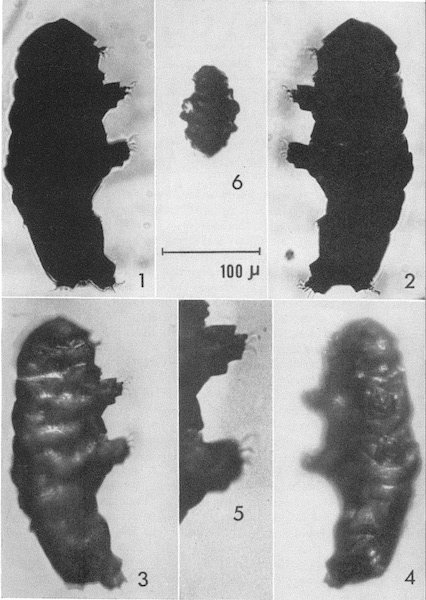
What are Water Bears
Tardigrades, more commonly known as "Water Bears" are tiny little 8 legged invertebrates measuring between 0.02 in (0.5 mm) - 0.047 in (1.2mm). They were first discovered in 1773 and have since been found just about everywhere, including the most extreme environments on Earth. Tardigrades are considered the hardiest animal on Earth, able to survive near Absolute Zero (−458 °F; −272 °C) up to about 300 °F ( 150 °C). These little survivors have been found in boiling hot springs, the top of the Himalayas and even the freezing waters off Antartica.

Tardigrades have been on Earth for around 500 Million years and there are over 1,100 species of them. Tardigrades have a head, a 3 - segmented barrel shaped body, 4 pairs of legs and a rear body segment. Most Tardigrades have "eyes" or photo-receptors similar to most insects. They have brains, and tubular mouths with a digestive system. They do not have a respiratory system, but rather "breathe" through their skin. Some Tardigrades are asexual but most require a male and female Tardigrade for reproduction.
So What's So Special
These tiny little creatures are considered to be practically invincible. Scientists have revived them from being frozen for 30 years, after which they lived and even went on to reproduce. Tardigrades have even been sent into outer space and left in a vacuum exposed to Space Radiation. They were revived and survived when they returned to Earth. These animals have the key or rather keys to surviving in both extreme environments as well as during a long hibernation. Their ability to survive all extremes, including losing 97%- 99% of the liquid in their bodies, for up to 30 years has scientist studying them for their secrets to invincibility.

Since Mars is the next frontier, Outer Space Exploration will expose the human body to Space Radiation. Traveling to Mars will require a long time in Space without the protection of Earth's Magnetic Field. This has the potential of exposing the travelers to Mars with lethal doses of Space Radiation. Since Tardigrades are known to withstand 1000 times more radiation than most organisms without cellular breakdown or death, their DNA is being studied. Scientists have recently discovered a protein that the Tardigrades use to help protect their cells from radiation damage. The study revealed that human cultured cells were able to survive about 40% more radiation than normal when treated with this one Tardigrade protein. The scientists will continue to look for other secrets to the Tardigrades ability to withstand DNA damage from radiation, since there must be other proteins or mechanisms that protect them from radiation 1000's times stronger than what the human cultured cells were able to withstand.

-Mars, We Are Coming!
Full $teem Ahead!
My Top Blogs
- Students Protest Trump
- The Trump Protests Continue
- My First Bounty Hunt

Signature Logo Created by @czar
if you need one, he is steem dollars reasonable!
Image Sources:
(labeled for re-use)
Picture 1
Picture 2
Picture 3
Picture 4
Resources:
Wikimedia.org
https://www.siliconrepublic.com/innovation/alien-life-astrobiology-penelope-boston
https://www.siliconrepublic.com/innovation/tardigrade-water-bear-cryogenics
http://jamanetwork.com/journals/jama/article-abstract/2576576
This was very interesting. Be nice to see what can be developed from these water bears. I do not think i have ever seen one.
Downvoting a post can decrease pending rewards and make it less visible. Common reasons:
Submit
Some think these little guys could have actually survived a space trip here, who knows but they are super tough. Glad they aren't bigger or deadly, right?
Downvoting a post can decrease pending rewards and make it less visible. Common reasons:
Submit
have you looked for one?
they are umbiquitious...they exist on EVERY continent including Antarctica.
Downvoting a post can decrease pending rewards and make it less visible. Common reasons:
Submit
lol. i have not looked for one. be assured, i know what they look like now. just dont recall ever coming across one.
Downvoting a post can decrease pending rewards and make it less visible. Common reasons:
Submit
It's fun to make things up... wait! This is real?! I read some cool stuff today but this is my favorite! After they are frozen and thawed out, do they suffer from hibernation sickness?

Downvoting a post can decrease pending rewards and make it less visible. Common reasons:
Submit
They are real. Supposedly if you soak some moss or lichen, they should come floating out and able to see them under a microscope. As for re-animation, I think that it took the water bears a little bit of time before coming back to normal. I think there was an egg or embryo that came back to life but it took a much longer time than normal, making it seem like it was "taking its time" and slowly "coming back" until it did.
So for now, they were able to make cultured human cells survive 40% more radiation than before using a protein from these little guys. But they can survive thousands times more so there must be more to them.
Downvoting a post can decrease pending rewards and make it less visible. Common reasons:
Submit
While dangerously high levels of space radiation are a threat as you described, I think a more immediate scientific breakthrough comes from studying their water regulation in freezing temperature. Somehow, their cells, which are mostly water like human cells, are able to withstand freezing temperatures without forming ice crystals which normally destroys cells. Understanding the differences in their cellular temperature regulation in extreme cold could give us clues about the feasibility of cryopreservation for long distance space travel or other medical purposes on Earth.
Downvoting a post can decrease pending rewards and make it less visible. Common reasons:
Submit
@thesilentmantis Space travelers will need both radiation protection and some sort of cryogenic sleep/hibernation. As for freezing, somehow their cells know to reduce their water composition to 1%- 3% otherwise the cells would rupture since water expands when freezing.
This has spawned another idea for a post, although not really related.
Downvoting a post can decrease pending rewards and make it less visible. Common reasons:
Submit
Tardigrades are quite fascinating little creatures! Pretty impressive that they can survive when there is almost no molecular motion (you listed -272 celcius.. so 1 Kelvin... pretty nuts!)
Downvoting a post can decrease pending rewards and make it less visible. Common reasons:
Submit
Yup 1 Kelvin , for a few minutes @justtryme90 and a few days at minus -200 Celsius.
Downvoting a post can decrease pending rewards and make it less visible. Common reasons:
Submit
That's just amazing to me.
Downvoting a post can decrease pending rewards and make it less visible. Common reasons:
Submit
And 30 years at - 20 Celsius ! And some of their species can survive 6x's the pressure found in the deepest ocean trenches @justtryme90 .
Downvoting a post can decrease pending rewards and make it less visible. Common reasons:
Submit
I wonder what the evolutionary stimulus was to develop these characteristics.
Downvoting a post can decrease pending rewards and make it less visible. Common reasons:
Submit
My theory is that being so small makes them very vulnerable and susceptible to many things in the environment from climate, radiation, toxins and other factors. For example, a drop from boiling water won't kill you or I, but will kill an ant.
My simple 2 cents anyway.
Downvoting a post can decrease pending rewards and make it less visible. Common reasons:
Submit
Great article. I learned something new, too!
Downvoting a post can decrease pending rewards and make it less visible. Common reasons:
Submit
I LOVE TARDIGRADES!
Downvoting a post can decrease pending rewards and make it less visible. Common reasons:
Submit
Hi @stellabelle Thanks for stopping by, it is truly appreciated.
And yeah, tardigrades (I like water bears better) are pretty cool. lol
Downvoting a post can decrease pending rewards and make it less visible. Common reasons:
Submit
For further information, there were two very nice tardigrades articles published on Steemit a few months ago by @cristi. I recommend them greatly: here and there.
Downvoting a post can decrease pending rewards and make it less visible. Common reasons:
Submit
thanks for that @lemouth @cristi does an excellent job.
Downvoting a post can decrease pending rewards and make it less visible. Common reasons:
Submit
Definitely :)
Downvoting a post can decrease pending rewards and make it less visible. Common reasons:
Submit
They are very interesting little creatures. I'd like to see one that's about 200kg. lol
Downvoting a post can decrease pending rewards and make it less visible. Common reasons:
Submit
Your statement reminds me of those 50's movies with Giant Ants and Spiders, although somehow a giant Water Bear just doesn't conjure up the same scary feeling @solarguy , rather, they might be fun to ride at the size.
Downvoting a post can decrease pending rewards and make it less visible. Common reasons:
Submit
This post has been ranked within the top 10 most undervalued posts in the first half of Nov 16. We estimate that this post is undervalued by $13.52 as compared to a scenario in which every voter had an equal say.
See the full rankings and details in The Daily Tribune: Nov 16 - Part I. You can also read about some of our methodology, data analysis and technical details in our initial post.
If you are the author and would prefer not to receive these comments, simply reply "Stop" to this comment.
Downvoting a post can decrease pending rewards and make it less visible. Common reasons:
Submit